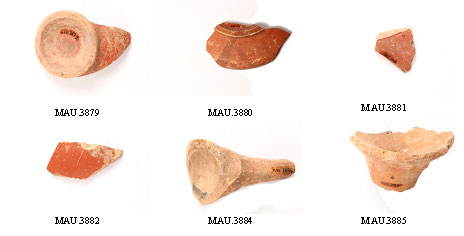During a prospection conducted in June 6, 2011, by the
Groupe d’Études et de Recherches Souterraines du Liban (G.E.R.S.L.) in the valley of Qadisha, the members of the group discovered a cavern that hitherto had remained unknown. They named it the “Saint Stephen Hermitage”.
Notes on the Ceramics of Saint Stephen’s Hermitage, Qadisha (Lebanon)
Grace Homsy-Gottwalles
The quantity of ceramics found during the prospection of the cavern called the “Saint Stephen Hermitage”, in the Qadisha Valley, undertaken by the G.E.R.S.L. (
Groupe d'Études et de Recherches Souterraines du Liban) is relatively tenuous; 6 fragments of ceramic, one fragment of floor tile and a perforated stone.
The identification of ceramics is, however, very interesting. The Eastern Sigillata A constitutes the most significant grouping from a quantitative point of view. This type includes two representative fragments (bases), a bowl (Fig. 1-MAU.3879) corresponding to the Hayes 22 form and a plate with full profile (Fig. 1-MAU.3880) that has its equivalent in the Hayes 4A form; in addition to two shards of plates, the fragmentary state of which does not allow a full reconstruction (Fig. 1-MAU.3881, MAU.3882). This assemblage of Eastern Sigillata date back to the end of the second century B.C. to the year 10 A.D. (1)
The Eastern Sigillata A appeared in the middle of the second century B.C., in the Eastern Mediterranean. This molded ceramic is characterized by a yellow or beige limestone fabric with a red slip cover. Normally resistant and glossy, it can be shelled on untreated objects; a darker painted band made by a successive immersion of the ceramic in the slip clay may appear on the Eastern Sigillata A. The plate MAU.3880 of our material represents the traces of this double immersion. The origin of this production is still undefined. However, the most possible provenance can be Levantine (Cyprus, Lebanon, Palestine, Syria).(2)
The prospection also delivered a base fragment of unguentarium dating back to the first century B.C. (Fig. 1-MAU.3884), and a base fragment of amphora of Handle Amphora type, originating probably from Saïda, that goes back to the second century B.C. (Fig. 1-MAU.3885) (3).
In addition to this collection of homogenous ceramics characterizing the end of the Hellenistic period, they also unearthed an oval stone shape, with a circular hole and a basalt tile floor, with date to be defined due to the absence of elements of observation (Fig. 2-MAU.3886 and MAU.3883).
The ceramics discovered in the Saint-Stephen Hermitage are very important. This discovery leads us to raise a fundamental question; how and why the ceramics dated to the end of the Hellenistic period are found in this cavern? A more detailed prospection and/or an extensive survey, more specifically under the floor, may give an answer.
(1) For the Hayes 22 form, see Hayes J. W., 1985, p. 23, pl. III-9 and for Hayes 4A form, see p. 16. pl. I-9.
(2) Hayes J. W., 2001, p. 146.
(3) Ala’eddine A., 2003, pp. 110-111 and 118.
| MAU.3879 |
Bowl. Annular Base. Limestone fabric, D. 6.9 cm; Th. 0.6 cm; 6/6 5YR reddish yellow. Crackled red slip on the internal and external surfaces, 5/8 10R red.
|
| MAU.3880 |
Plate. Full Profile: Annular Base, Hemispherical body, thinned rim. Limestone fabric, D. 14 cm, D. 27 cm, Th. 1 cm, Th. 0.3 cm; 8/4 10YR Light Brown. Bright red slip internal and external surfaces, 4/6 10R red. Presence of a double dipping band internally and externally.
|
| MAU.3881 |
Plate. Body fragment. Limestone fabric, Th. 0.7 cm; 8/4 10YR light brown. Bright red slip on the internal and external surfaces, 4/6 10R red.
|
| MAU.3882 |
Plate. Body Fragment. Limestone fabric, Th. 0.7 cm; 8/4 10YR light brown. Bright red slip on the internal and external surfaces, 4/6 10R red. |
| MAU.3884 |
Unguentarium. Base Fragment. Sandy Fabric, .H. 10.85 cm; 6/6 2.5YR light-red, 4/1 7.5YR dark grey.
|
| MAU.3885 |
Amphora. Base Fragment. Sandy fabric, H. 6.65 cm; 5/3 5YR reddish brown, 5/1 7.5YR grey.
|
| MAU.3886 |
Tile floor. Fragment. Basalt. Th. 2.4 cm; black.
|
| MAU.3883 |
Oval stone, with a circular hole. Basalt, D. 8.75 cm, Th. 5 cm; black. |

 Bibliography
Bibliography
- Hayes John W., “Sigillate Orientali”, in Enciclopedia dell’Arte Antica Classica e Orientale, Atlante delle Forme Ceramiche II, Ceramica Fine Romana nel Bacino Mediterraneo (Tardo Ellenismo e Primo Impero), Rome, Istituto Treccani, 1985, p. 1-96.
- Hayes John W., “Les sigillées orientales”, in Pierre Lévêque and Jean-Paul Morel (dir.), Céramiques hellénistiques et romaines, III, Paris, Presses Universitaires Franc-Comtoises, 2001, p. 145-160.
- Ala’eddine Abdallah, “Hellenistic Stamped Amphorae from Beirut (site code Bey 004)”, Archaeology and History in Lebanon, Issue Seventeen: Spring 2003, p. 109-119.